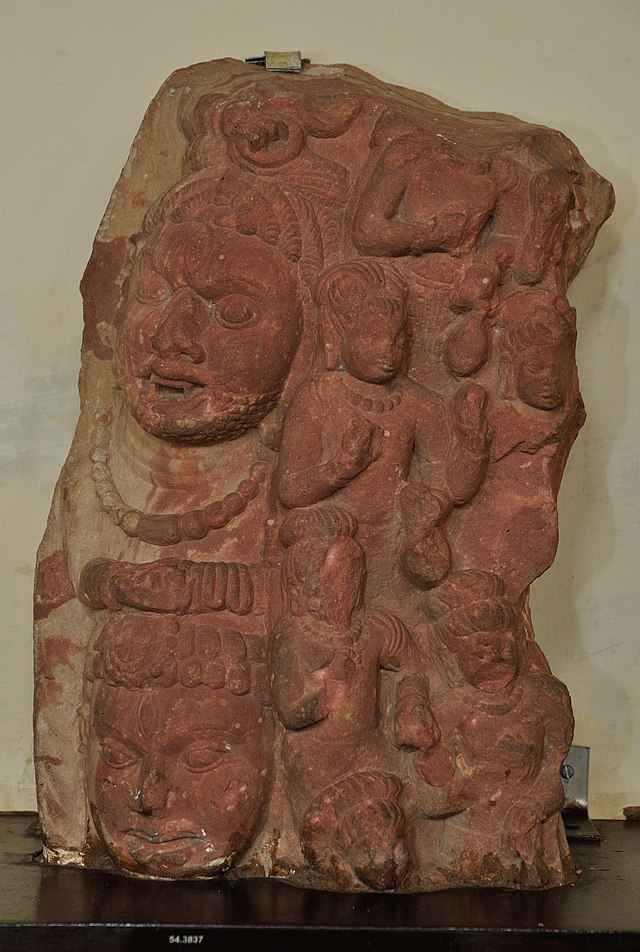Top Qs
Timeline
Chat
Perspective
Thirty-three gods
Group of deities of Hinduism From Wikipedia, the free encyclopedia
Remove ads
The Thirty-three gods, or Tridasha (Sanskrit: त्रिदश, romanized: Tridaśa, lit. 'three tens'), is a pantheon of Hindu deities of the current manvantara.[1][2] The Samhitas, which are the oldest layer of text in the Vedas, enumerate 33 deities classified as Devas, either 11 each for the three worlds, or as 12 Adityas, 11 Rudras, eight Vasus and two Ashvins in the Brahmanas.[3][4]

Remove ads
List
Summarize
Perspective
The thirty-three deities are:
- Eight Vasus (deities of material elements) – Dyaus (sky), Prithvi (earth), Vayu (wind), Agni (fire), Nakshatra (stars), Varuna (water), Surya (sun), Chandra (moon)
- Twelve Adityas (personified deities) – Indra (Shakra), Aryaman, Tvashtr, Varuna, Bhaga, Savitr, Vivasvat, Amsha, Mitra, Pushan, Daksha, Vishnu (this list sometimes varies in particulars)
- Eleven Rudras, consisting of Aja, Ekapada, Ahirbudhanya, Tvasta, Rudra, Hara, Sambhu, Trayambaka, Aparajita, Ishana, and Tribhuvana
- Two Ashvins (or Nasatyas), twin solar deities
Variations
The list of deities varies across the manuscripts found in different parts of South Asia, particularly in terms of the Ashvins and the personified devas. One list based on Book 2 of the Aitereya Brahmana is:[5][6]
- Devas personified: Indra (Shakra), Varuna, Mitra, Aryaman, Bhaga, Amsha, Vidhata,[7] Tvashtr, Pushan, Vivasvat (Surya), Savitr (Dhatr), Vishnu
- Devas as abstractions or inner principles: Ananda (bliss, inner contentment), Vijnana (knowledge), Manas (mind, thought), Prana (life-force), Vac (speech), Atma (Self), and five manifestations of Rudra – Ishana, Tatpurusha, Aghora, Vamadeva, Sadyojata
- Devas as forces or principles of nature – Prithvi (earth), Agni (fire), Antariksha (atmosphere, space), Jala (water), Vayu (wind), Dyaus (sky), Surya (sun), Nakshatra (stars), Soma (moon)
- Devas as guides or creative energy – Vasatkara, Prajapati
The reported identity of the two Ashvins sometimes varies:
There are eight Vasus, eleven Rudras, twelve Âdityas; and these two, Heaven and Earth, are the (thirty-second and) thirty-third. And there are thirty-three gods, and Pragâpati is the thirty-fourth;--thus he makes him (the sacrificer, or Yagña) to be Pragâpati 2: now that 3 is, for that is immortal, and what is immortal that is. But what is mortal that also is Pragâpati; for Pragâpati is everything: thus he makes him to be Pragâpati, and hence there are these thirty-four utterances, called expiations. [note 1][8]
— Satapatha Brahmana 4:5:7:2
Remove ads
Literature
The Brihadaranyaka Upanishad describes the existence of these deities with a different lineup:[9]
Yājñavalkya said, 'These are but the manifestations of them, but there are only thirty-three gods.' 'Which are those thirty-three?' 'The eight Vasus, the eleven Rudras and the twelve Ādityas—these are thirty-one, and Indra and Prajāpati make up the thirty-three.'
— Brihadaranyaka Upanishad, Section 9, Verse 3.9.2
Remove ads
See also
- Trāyastriṃśa, the Buddhist equivalent
Notes
- aṣṭau vasavaḥ : ekādaśa rudrā dvādaśādityā ime eva dyāvāpṛthivī trayastriṃśyau trayastriṃśadvai devāḥ prajāpatiścatustriṃśastadenam prajāpatiṃ karotyetadvā astyetaddhyamṛtaṃ yaddhyamṛtaṃ taddhyastyetadu tadyanmartyaṃ sa eṣa prajāpatiḥ sarvaṃ vai prajāpatistadenam prajāpatiṃ karoti tasmādetāścatustriṃśadvyāhṛtayo bhavanti prāyaścittayo nāma.
References
Wikiwand - on
Seamless Wikipedia browsing. On steroids.
Remove ads
